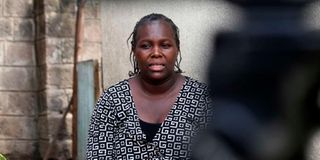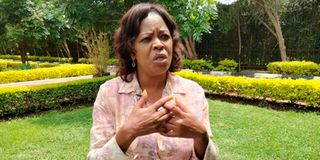A story of gender-based violence; but where are the safe homes?
What you need to know:
- There are many girls, women, boys and men experiencing GBV, who urgently need a safe place but can’t find any.
- Shelters are overstretched with many on the edge of shutting down due to financial constraints.
- Maisha Girls safe house, MaryFaith Children’s Centre and Woman’s Hope shelter, constitute the 36 shelters in Kenya not enough to accommodate the rising cases of GBV in the country.
We meet ten-year-old Aisha (not her real name) at Maisha Girls safe house in Eastlands, Nairobi County. She adorns a flowered jumpsuit as bright as her face. A few minutes after taking a seat on a plastic chair on the veranda at the safe house, the dazzled brightness from this little girl dims.
As she swings her legs and pensively folds her fingers, tears roll down her cheeks. It is tormenting just looking at her even before she shares her story. We give her time as we prepare ourselves emotionally.
Aisha has been here since early February. She is recovering from a fistula corrective surgery. Her anus and vagina are badly injured.
Her mother’s boyfriend brutally defiled her in Viwandani, Industrial Area in Nairobi County. Her drunkard mother who had slept out on the day Aisha was defiled, could not take her word for the heinous act, instead saying she was lying.
It is the neighbours who noticed her difficulties in walking and rescued her. They took her to Industrial Area Police Station from where she was referred to the safe house.
The suspect has since disappeared and the mother has not made any effort to reclaim the rights of her daughter.
Currently, this safe house is the only secure place Aisha calls her home.
Sadly though, there are many girls, women, boys and men like her, who urgently need a safe place but can’t find any. Shelters are overstretched with many on the edge of shutting down due to financial constraints. Some have already closed.
This shelter, for instance, should ideally accommodate 24 girls and women aged 10 to 20. But currently, they are 52 with the oldest being 22 years. A number of them have children, while others are expectant. Some are nursing injuries from defilement or rape.
Reject survivors
The founder of the shelter Ms Florence Keya, says she used to receive two to five cases a month before Covid-19 hit Kenya in March last year. The number has since ballooned to a daily average of seven.
She has been forced to turn others away and reintegrate some to create space. Sometimes she hits a wall – some families reject survivors yet children’s homes cannot accommodate them because they are 18 or older.
If she gets funding, Ms Keya says she could create more space.
“There are so many cases (of abused girls and women). I have turned away many because we couldn't fit, yet I know a person who has been sexually abused wants to first put a foot in a place where they feel secure,” she says
She says 99 per cent of the survivors are victims of sexual violence committed by relatives or people known to them namely fathers, step-fathers, step-brothers, cousins, uncles and their mothers’ lovers.
At MaryFaith Children’s Centre, in Dagoretti, Nairobi County a look at the rescued girls aged 13 to 17 sunning outside is tear-jerking.

Nereah Akoth, a counsellor with Centre For Rights Education and Awareness during the interview on April 27, 2021.
Some are pregnant, others are breastfeeding their new-borns while their colleagues look after their infants playing around the compound.
There are 72 of them here, an excess of 12. The extra landed at the centre between March 27 and April 26, this year. The police referred the girls, who are mainly survivors of incest and child marriages, Ms Mary Njeri Daniel the centre’s founder, says.
We find her sieving through her records to identify potential donors to fill the deep hole of lack in basic needs.
She has not received donations from her usual well-wishers since last year as most lost their sources of income due to the economic disruptions caused by Covid-19.
For now, she needs a monthly batch of Sh85,000 to feed the children and a further Sh200,000 for their medical expenses.
In this shelter is a girl with a two-month-old baby who needs special milk to survive. She was born with low glucose levels. She also needs specialised care to heal from her Caesarean care wounds. All these expenses, Ms Daniel cannot afford at the moment.
Further still, the girl has no place to go. She came to Nairobi from Moyale last year, to work as a house girl after her guardian rejected her. She neither knows her mother nor father.
She ended up pregnant with a boyfriend whom she met in Nairobi. The man later wanted to poison her upon realising she was pregnant. While she finds home in the shelter, the shelter’s future is shaky.
Ms Daniel says she is uncertain of what the status of the shelter will be like May this year when the funds at their disposal run out, yet there is no sight of an incoming donor.

Ms Consolata Waithaka director of Woman's Hope in Karen, at the centre in Nairobi County on April 26,2021.
Some 13km away from Ms Daniel’s shelter is Woman’s Hope.
It is in a serene and exclusive environment in the suburbs of Karen, Nairobi County.
There are 30 women sheltered here, half its normal capacity of 60. Unlike other shelters, this one takes in women with their children.
The director of the centre Ms Consolata Waithaka, can’t admit more women. She is already struggling to meet the needs of the 30.
Had it not been for the saving hand of UN Women and Centre for Rights Education and Awareness, she says she could have closed in April last year.
Unfortunately, the funding is short-term. It ends in a month and what has been running in her mind day and night is: “How am I going to sustain these women?”
For the past 11 months, Ms Waithaka receives at least three requests each day, but is painfully forced to decline owing to limited financial resources.
“It saddens me when someone calls (seeking refuge) and I have to say no,” she says.
There are, however, situations when she is forced to admit a survivor, especially when she is at the risk of death.
On May 1, she will lead Adopt-A-Family walk at Ngong’ sanctuary to fundraise for the centre.
Maisha Girls safe house, MaryFaith Children’s Centre and Woman’s Hope shelter, constitute the 36 shelters in Kenya. Going by an average of 30 survivors in each shelter that translates to just 1,080, a very small proportion of the 5,009 sexual and gender based violence (SGBV) cases reported between January and December 2020.
With the deep financial constraints forcing some to shut, the capacity is even leaner now, which means many remain victims of repeated abuse without hope for a safe haven.
Nainyoie Safe House in Samburu County was shut down in December last year.
And the 20 girls aged eight and 14 years, then in the shelter, some of whom were survivors of female genital mutilation (FGM) and child marriages, returned to their homes.
County support lacking
“We had to close because we didn’t have even basics like food. Our county government does not support us. We rely on donors and most of them have pulled out because they are also facing their own challenges in their countries,” says the shelter director Ms Irene Leshore.
For others, the idea of taking in new cases in the era of infectious Covid-19, is daunting amidst the struggles of fundraising.
“Running a shelter is a very expensive venture. We have not been funded at all, neither does the government support us. We depend on well-wishers. We struggle to make ends meet,” says Ms Janepher Musuya, a program associate at Kisumu Medical and Education Trust (KMET) which runs KMET Freedom House Safe Space.
She says: “There are always weekly requests for space, but the biggest dilemma has been how you get them tested first for Covid-19.”
Each week, they register at least five requests including from abused married women, yet they can only accommodate four at any given time and only those within the nine to 24 age bracket.
These high demands for safe spaces without hope for help, leave shelter providers in psychological trauma.
“A part of me dies when I am unable to help a girl who wants my support,” says Ms Keya, founder of Maisha Girls safe house.
It is a similar case for Ms Daniel, founder of MaryFaith Children’s Centre.
She says: “Sometimes I look like I am crazy because I am stressed out over where to get the money to cater for their medical and psychosocial support and necessities such as food and clothing.”
Sammy Muraya of the Voice for Women and Girls' Rights, Kenya said the Ministry of Gender released a report that indicated a massive rise in the number of reported GBV cases in 2020.
There were 5,009 cases reported by the end of 2020 compared to 1,411 cases that were reported in 2019.
“We can at least applaud the government for issuing hotline numbers where people can report gender violence issues, but the question still remains what next after reporting? We don't have enough shelters, and in most instances when victims seek refuge at police stations they are forced to spend nights in police cells because there is nowhere else for them to go.
“This has contributed largely to victims going back to their abusers and some cases being bungled up. We need to have safe spaces or shelters in each constituency,” said Mr Muraya.





